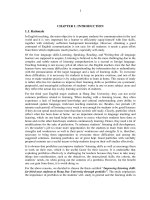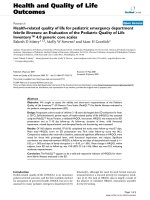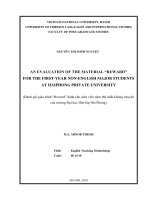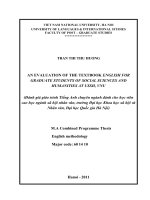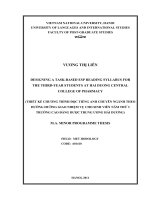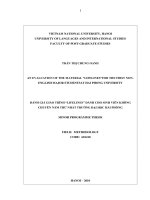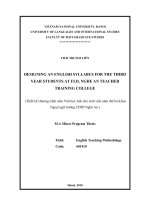An evaluation of the ESP course for third year students at industrial economics and technology college m a thesis linguistics 60 14 0
Bạn đang xem bản rút gọn của tài liệu. Xem và tải ngay bản đầy đủ của tài liệu tại đây (302.4 KB, 75 trang )
VIETNAM NATIONAL UNIVERSITY, HANOI
UNIVERSITY OF LANGUAGES AND INTERNATIONAL STUDIES
FACULTY OF POST-GRADUATE STUDIES
*********************
ĐẶNG THỊ MINH HUỆ
AN EVALUATION OF THE ESP COURSE FOR THIRD-YEAR STUDENTS
AT INDUSTRIAL ECONOMICS AND TECHNOLOGY COLLEGE.
Đánh giá một khóa học tiếng Anh chuyên ngành cho sinh viên năm 3 tại
trường Cao đẳng Công nghệ và Kinh tế Công nghiệp
.
M.A MINOR PROGAMME THESIS
FIELD: ENGLISH TEACHING METHODOLOGY
CODE: 60140111
.
Hanoi, 2015
VIETNAM NATIONAL UNIVERSITY, HANOI
UNIVERSITY OF LANGUAGES AND INTERNATIONAL STUDIES
FACULTY OF POST-GRADUATE STUDIES
*********************
ĐẶNG THỊ MINH HUỆ
AN EVALUATION OF THE ESP COURSE FOR THIRD-YEAR STUDENTS
AT INDUSTRIAL ECONOMICS AND TECHNOLOGY COLLEGE.
Đánh giá một khóa học tiếng Anh chuyên ngành cho sinh viên năm 3 tại
trường Cao đẳng Công nghệ và Kinh tế Công nghiệp
.
M.A MINOR PROGAMME THESIS
FIELD: ENGLISH TEACHING METHODOLOGY
CODE: 60140111
SUPERVISOR: DƯƠNG THU MAI, PhD.
Hanoi, 2015
DECLARATION
I hereby certify that this thesis is entirely my own work. I have provided fully
documented references to the others' work. The material in this thesis has not been
submitted for assessment in any other formal course. I also accept all the
requirements of ULIS relating to the retention and use of M.A Graduation Thesis
deposited in the library.
Thai Nguyen, September, 2014
Dang Thi Minh Hue
i
ACKNOWLEDGEMENTS
I would like to express my gratitude to all who have helped me in the completion of
this thesis.
Firstly, I am deeply indebted to my supervisor, Duong Thu Mai, Ph.D for her
valuable guidance, useful suggestions, kind encouragement while I was doing my
research.
Secondly, many thanks also go to my classmates in K21- University of Languages
& International Studies- VNU, Hanoi for their support, and suggestions during the
thesis.
Thirdly, I am grateful to my colleagues and students at Accountancy Faculty at
Industrial Economics and Technology College for their willingness to participate in
the research without whose support I could not complete this project.
Last but not least, a special note of appreciation goes to family who always supported
me with their sympathy and encouragement to complete this study.
Thai Nguyen, September 2014
Đặng Thị Minh Huệ
ii
ABSTRACT
Course evaluation in light of learner-centered teaching approach is found to be
significantly important at Industrial Economics and Technology College where no
evaluation of the ESP course has been conducted. This study attempts to evaluate the
Business and Economics course in the 4 aspects: Function of content, roles of the
instructor, responsibilities for learning, and processes and purposes of assessment in
the perspective of students and teachers. To fulfill such objectives, the study
employed the instruments of questionnaires and interviews administered for 80
students and 09 English teachers respectively. The data collected from the
questionnaires was analyzed in graphs, tables, charts meanwhile information
collected from the interview was summarized interpretively. After comparing the data
collected from students and teachers, inferences were made regarding the strengths
and weaknesses of the course. The findings show that purposes and processes of
assessment were done well, some parts in responsibilities for learning and roles of the
instructor should be strengthened, content of the course should be reconsidered about
amount of knowledge. Finally, some recommendations for improving the course's
effectiveness were introduced.
iii
TABLE OF CONT
DECLARATION .....................................................................................................
ACKNOWLEDGEMENTS.....................................................................................
ABSTRACT..........................................................................................................
LIST OF ABBREVIATIONS................................................................................
LIST OF TABLES AND FIGURES.....................................................................
PART A: INTRODUCTION ...................................................................................
1.Rationale of the study ....................................................................
2.Aims and objectives of the study ...................................................
3.Research questions ........................................................................
4.Scope of the study .........................................................................
5.Methods of the study .....................................................................
6.Organization ..................................................................................
PART B: DEVELOPMENT....................................................................................
CHAPTER 1: LITERATURE REVIEW..................................................................
1.1 English for Specific Purposes (ESP). .............................................................
1.1.1 Definitions on English Specific Purposes ............................
1.1.2Characteristics of E
1.1.3The approach in te
1.2 Course evaluation ........................................................................................
1.2.1What is Course Ev
1.2.2The importance of
1.2.3The framework use
CHAPTER 2: METHODOLOGY .........................................................................
2.1 The practical background of the study..........................................................
2.1.1Research site ........
2.1.2ESP course ...........
2.2 Participants ..................................................................................................
iv
2.2.1 Students..................................................................................................................... 24
2.2.2 Teachers..................................................................................................................... 24
2.3 Data collection................................................................................................................. 24
2.3.1 Data collection instrument.................................................................................... 24
2.3.2 Data collection procedure...................................................................................... 27
2.3.3 Data presentation and analysis procedure......................................................... 28
CHAPTER 3: FINDINGS AND DISCUSSION.................................................................. 30
3.1 Course evaluation in terms of learner-centeredness from the perspective of
students..................................................................................................................................... 30
3.1.1. Function of content................................................................................................ 30
3.1.2. Role of the teacher................................................................................................. 32
3.1.3 Responsibility for learning.................................................................................... 34
3.1.4. Purposes and processes of assessment.............................................................. 35
3.2 Course evaluation in terms of learner-centeredness from the perspective of
teachers..................................................................................................................................... 37
3.2.1 Function of content................................................................................................. 37
3.2.2 Role of the teacher.................................................................................................. 39
3.2.3 Responsibilities for learning................................................................................. 39
3.2.4 Purposes and processes of assessment............................................................... 40
3.3 Discussion......................................................................................................................... 41
3.3.1 Function of the content.......................................................................................... 41
3.3.2 Roles of the teacher................................................................................................. 42
3.3.3 Responsibilities of the learner.............................................................................. 44
3.3.4 Purposes and processes of assessment............................................................... 45
PART C: CONCLUSION.......................................................................................................... 47
1. Summary of findings and discussions.......................................................................... 47
2. Recommendations............................................................................................................. 48
3. Limitations.......................................................................................................................... 50
4. Suggestions for further research..................................................................................... 50
v
REFERENCES............................................................................................................................ 51
APPENDICE................................................................................................................................... I
vi
LIST OF ABBREVIATIONS
ESP: English for Specific Purposes
IETC: Industrial Economics and Technology College.
vii
LIST OF TABLES AND FIGURES
LIST OF TABLES
Table 1.1: Comparison of Teacher-learner teaching and Learner-centered teaching on
five key elements (Saulnier et al., 2008; Weimer, 2002). Table 1.2:
The rubric role for the role of the instructor dimension of learner-centered Teaching
(Blumberg P., 2009)
Table 3.1: Strengths and weaknesses of the ESP course
LIST OF FIGURES
Figure 3.1: Students' evaluation of the course's content.
Figure 3.2: Student's evaluation of the teacher's role
Figure 3.3: Students' evaluation on their learning responsibility
Figure 3.4: Students' evaluation on the opportunities to develop self and peer
assessment skills.
Figure 3.5: Students' evaluation on enhancing their potential to promote learning by
many assessments.
Figure 3.6: Students' satisfaction about the course's content of the ESP course
Figure 3.7: Students' satisfaction about the role of teacher in the ESP course
Figure 3.8: Students' satisfaction about responsibilities for learning
Figure 3.9: Students' satisfaction about the purposes and processes of the assessment.
viii
PART A: INTRODUCTION
1. Rationale of the study
With the globalization of trade and economy and the continuing increase of
international communication in various fields, the demand for English for Specific
Purpose is increasingly expanding, especially in universities and colleges where they
desire to provide their students some line knowledge. Then, English-teaching teachers
are required to design ESP courses. The core components of an ESP course include
needs analysis, course goal and objectives; materials design and finally assessment
and evaluation, which must be developed from the learner's targets, needs, abilities,
situation,...
Evaluation of an ESP course is especially important. Evaluation is defined as "a
whole process which begins with determining what information to gather and ends
with bringing about change in current activities or influencing future ones" (Evans,
1998, p.128). Evaluation could be performed in any fields, any projects because it
could help the insiders and outsiders understand how the thing is and give out
improvement or innovation where it is needed. It is essential in our daily life, in
education also. With learners, it is to judge, make comments on the teaching and
learning activity to adjust their own learning. Addition to that, "evaluation of the
learners is unlikely to indicate exactly where a fault lies, but it will at least indicate
the existence of a fault somewhere" (Hitchinson and Waters, 1987, p.145). With
teachers, they need evaluation "because it can provide a wealth of information to use
for the future direction of classroom practice, for the planning of the courses, and for
the management of learning tasks and students" for to “confirm the validity of the
classroom practice” when any partial elements of the course are satisfactory and
“form a basis” for changes when they are not" (Germaine et al., 1992).
Among many frameworks which could be used for course evaluation, this study used
the learner-centered teaching approach which has been increasingly appreciated
highly in education in Vietnam. In addition, it is one of the most
1
appropriate frameworks for evaluating an ESP course when with an ESP course, the
core element is the learners who are "active participant in learning and coconstructors of knowledge" (Meece, 2003). In other words, in a learner-centered
course, it is the learner who must be responsible for their learning, the instructor just
acts as a mentor and an advisor to encourage students' participation in active learning.
Interactions between the instructor and their students facilitate the learning process
through discovery, inquiry and problem solving (Law, 2007).
In the context of teaching English for Specific Purposes, the evaluation of a course is
significantly important at Industrial Economics and Technology College given the
context described hereafter. Every year, Industrial Economics and Technology
College provides several ESP courses in the fields of accountant, finance and
banking, mechanics, electricity, information technology for total of around 1,500
students before they leave the College. The College does that to equip the necessary
knowledge on their line areas in English so that they could be sufficiently confident in
their latter job. To prepare for those courses, English-teaching teachers at the College
decide the targets, purposes, develop their materials, design syllabus and create tests
on their own without any guidance, instruction or framework from the higher
management levels. After teaching the course, there is no comment from their
learners. Their teaching is just evaluated by the test done by their students after
learning rather than any other methods. In other words, there has not had any
evaluation on how the course is, how the content is, how students inquiry knowledge
and skill for their future life, their coming job. Therefore, an evaluation of the ESP
course for third-year students at Industrial Economics and Technology College under
the guide of learner-centered teaching approach is important for the English-teaching
teachers to have some improvement or renovation for their better training activities.
2. Aims and objectives of the study
The study is aimed at evaluating the effectiveness of the English for Economics and
2
Business course. To achieve this aim, the study tries to:
Evaluate the English for Economics and Business course towards learner-centered
teaching approach in the perspective of students
Evaluate the English for Economics and Business course towards learner-centered
teaching approach in the perspective of teachers.
3. Research questions
With the above aims and objectives, the following questions were used for the study:
1. To what extent was the ESP course learner-centered from the perspective of
students?
2. To what extent was the ESP course learner-centered from the perspective of
teachers?
4. Scope of the study
The study was conducted with the assistance from non-English third-year students
after they fulfilled two General English classes, English for communication purpose
at Industrial Economics and Technology College.
Among several ESP courses conducted annually at Industrial Economics and
Technology, only the course of English for Economics and Business was chosen for
evaluation.
The evaluation focuses on the learner-centeredness of the course of English for
Economics and Business since it is one of the most appropriate approaches in
teaching ESP and evaluation is done in only 4 aspects: the function of content, role of
teachers, responsibilities for learning, and purposes and processes of assessment. 5.
Methods of the study
In this study, different techniques were employed. Firstly, an appropriate framework
has been selected which is developed by Blumberg (2009) for the course evaluation.
Secondly, to achieve the aims, the qualitative and quantitative approach utilizing
3
survey questionnaires and interview were used to collect the data. The method used in
this study was summative evaluation. In common, the data for the study could be
obtained through the following instruments:
The questionnaire was delivered to 80 third-year students at Industrial Economics and
Technology College to understand how they marked their learning in four aspects.
The interviews were used to get the feedback from the 09 lecturers of the course with
the same question items which were delivered in the questionnaire used for students
but with deeper and additional information.
After comparing the data collected from the questionnaires and interview, the study
could provide teachers another view on the course from the perspective of students,
and help them to infer the strengths and weaknesses of the course.
6. Organization
The thesis is under the title: "The evaluation of the ESP course for third-year students
at Industrial Economics and Technology College". The study will include 3 main
parts: Introduction, Development and Conclusion.
The first part of Introduction is a brief overview of the study with more detail about
rationale of the study, aims and objectives, research questions, scope, methods as well
as the organization of the study.
The second part of the Development includes 3 chapters. Chapter 1 refers to literature
review which provides the theoretical background for the study. In this part, some
important definitions of ESP, course, evaluation are mentioned with their
characteristics, importance, and components respectively. Importantly, the framework
for the evaluation is introduced. Meanwhile Chapter 2 deals with methodology
utilized for the study including: participants, studying methods, data collection
procedure and data analysis procedure. The chapter 3 focuses on findings and
discussion from the study. In this chapter, evaluation's results of the course in
4
terms of learner-centered approach are seen from the perspectives of students and
teachers.
The last part of conclusion clarifies strengths and weakness of the course, which are
drawn out from findings and discussion. Some recommendations are also introduced
for the teachers at Industrial Economics and Technology College. This part also
consists of limitations of and further suggestions for the study.
5
PART B: DEVELOPMENT
CHAPTER 1: LITERATURE REVIEW
To provide a good theory background for the study, this part will focus on two main
parts. The first is English for Specific Purposes including its definitions,
characteristics, and its components. The second is course evaluation which consists of
definitions, importance of course evaluation and importantly, the framework used for
evaluating an ESP course.
1.1 English for Specific Purposes (ESP).
With the globalization of trade and economy and the continuing increase of
international communication in various fields, the demand for English for Specific
Purpose is increasingly expanding. Johns & Dudley-Evans (2001, p.115) state that,
"the demand for English for specific purposes... continues to increase and expand
throughout the world". Coming back the past, it could be seen that English for
Specific Purposes arose as a term in the 1960s as it became increasingly aware that
General English courses frequently did not meet learners' and employers' wants.
Hutchinson and Waters (1987) gave three reasons for the emergence of ESP, the
demands of a brave new world, a renovation in linguistics and a new focus on the
learner. From the outset, the term ESP was an issue of many arguments as to what
exactly ESP?
1.1.1 Definitions on English Specific Purposes
To resolve argument what is and is not ESP, the division of ESP into absolute and
variable characteristics was initially helpful. The first person who defined ESP into
absolute and variable characteristics is Strevens (1988). Streven's definition of ESP
makes a distinction between 4 absolute characteristics and 2 variable ones. Four
absolute characteristics are (1) ESP is designed to meet specified needs of the
6
learner; (2) it is related in content (this is in its themes and topics) to particular
disciplines, occupations and activities; (3) it is centered on language appropriate to
those activities in syntax, lexis, discourse, semantics and so on, and analysis of the
discourse; and (4) it is in contrast with "General English". Two variable
characteristics mention to: (1) it may be restricted as to the learning skills to be
learned (for example reading only); and (2) it may not be taught according to any
preordained methodology. Those characteristics are then developed by Dudley-Evans
and St. John (1998) with 3 absolute characteristics and 4 variable ones. Absolute
characteristics are that (1) ESP is designed to meet specific needs of the learner; (2)
ESP makes use of underlying methodology and activities of the disciplines it serves;
(3) ESP is centered on the language (grammar, lexis, register), skills, discourse and
genres appropriate to these activities. Meanwhile 4 variable characteristics mention to
(1) ESP may be related to or designed for specific discipline; (2) ESP may use, in
specific teaching situations, a different methodology from that of General English; (3)
ESP is likely to be designed for adult learners, either at tertiary level institution or in a
professional work situation. It could, however, be used for learners at secondary
school level; and (4) ESP is generally designed for intermediate or advanced students.
Most ESP courses assume basic knowledge of the language system but it can be used
with beginner.
Hutchinson and Waters (1987, p.19) define ESP as an approach rather than a productmeaning that ESP does not involve a particular kind of language, teaching material or
methodology. The basic question of ESP is: Why does this learner need to learn a
foreign language? The purpose of learning English became to core. ESP, therefore, "is
an approach to language teaching in which all decisions as to content and method are
based on the learner's reason for learning".
Lorezo (2005, p.1) reminds us that ESP "concentrates more on language in context
than on teaching grammar and language structures". He also points out that as ESP is
usually delivered to adult students, frequently in a work related setting, that
7
motivation to learn is higher than in usual English as a Second Language contexts.
Carver (1983, p.134) believed that self-direction is important in the sense that an ESP
course is concerned with turning learners into users of the language.
In short, how ESP is defined, the core of ESP is the specific learner. The learner's
needs are analyzed before designing the ESP course, training objectives and the
reasons for studying are set, methodologies are done based on the learner's reason for
learning,...In other words, it is a way of teaching/learning English for specific
subjects with some specific vocational and educational purposes in mind. Therefore,
ESP is "as an approach rather than a product" (Hutchinson and Waters, 1987). For
further understanding, the next part will focus on the characteristics of an ESP course.
1.1.2 Characteristics of an ESP course
Characteristics of ESP courses could be also seen in the above definition of ESP by
Dudley-Evans and St John with 3 absolute characteristics and 5 variable
characteristics. Absolute Characteristics mean that ESP meets specific learners' needs,
uses "underlying methodology and activities of the discipline it serves" (DudleyEvans and St John, 1998, p.4) and is centered on language appropriate to these
activities in terms of "grammar, lexis, register, skills, discourse and genre" (p.5).
Variable Characteristics mean that ESP may be designed for specific disciplines, may
use "a different methodology from that of General English,...is likely to be designed
for adult learners, either at a tertiary level or in a professional work situation" (p.5)
and assumes some "basic knowledge of the language system" (p.5). This movement
has led to the production and the use of English courses aimed at specific disciplines;
for example, English for Medicine, English for Engineering, English for Business,
etc,. Hutchinson and Waters (1987, p.19) argue that "ESP is an approach to language
teaching in which all decisions as to content and method are based on the learner's
reason for learning".
8
Carter (1983) states that there are three features common to ESP courses: authentic
material, purpose-related orientation and self-direction. If one accepts Dudley-Evans'
(1997) claim that ESP should be offered at an intermediate or advanced level, then the
use of authentic learning materials is entirely feasible. Indeed, the use of authentic
content materials, modified or unmodified in form, is one feature of ESP, particularly
in self-directed study and research tasks. Meanwhile, purpose-related orientation
refers to the simulation of communicative tasks required of the target setting. A
sample activity associated with purpose-related orientation might include simulation
of a conference. Students would read papers written by others, practice note-taking,
prepare papers, practice networking with conference participants, etc. Finally, selfdirection is a characteristic of ESP courses in that the "....point of including selfdirection... is that ESP is concerned with turning learners
into users" (Carver, 1983, p.134). In order for self-direction to occur, the learners
must have a certain degree of freedom to decide when, what, and how they will study.
Facilitating this freedom might include teaching specific learning strategies related to
the discipline or occupation as "there must be a systematic attempt by teachers to
teach the learners how to learn by teaching them about learning strategies." (Carver,
1983).
Understanding the characteristics of the ESP course is very necessary with the
English-teaching teachers because out of being as a General English teacher, the ESP
teacher must work as a collaborator, a course designer and materials provider, a
researcher and an evaluator. The role of an ESP teacher could be seen more clearly in
the next part: components of an ESP course.
1.1.3 Components of an ESP course
In general, ESP course also has its same components of a General English course
including objectives of the course, teaching methods, training materials, syllabus,
content, assessment,... but they are also various when ESP is a relatively new
discipline within Applied linguistics that employs a new learner-centered approach to
English language teaching whose methodology is based on the specific needs of
9
the learner. Kennedy and Bilitho (1984, p.3) point out that ESP is based on "an
investigation of the purposes of the learner and the set of communicative needs
arising from those purposes". Therefore, needs analysis is a requirement for an ESP
course.
Needs analysis
Needs analysis and needs assessment are often used interchangeably. Some authors
claims that "assessment involves obtaining data whereas analysis involves assigning
value to those data" (Grave, 1996, p.12). Need analysis involves the assessment of
the needs for which the learners require language. In designing an ESP course, it is
imperative to carry out a need analysis to determine the specific reasons for learning
the language (Hutchinson & Waters, 1987). According to Nunan, "Techniques and
procedures for collecting information to be used in syllabus design are referred to as a
need analysis" (Nunan, 1988, p.13). Therefore, investigation of the needs analysis or
needs assessment is vital in an ESP course when it is usually followed by syllabus
design, selection of course materials, teaching/learning a course and its evaluation.
Aims and objectives
Aims and objectives are generally regarded as important because without aims to
provide direction, it is possible to be lost in the attempt to satisfy a range of shortterm objectives. After needs analysis is done, aims and objectives of the course are
set to develop the skills and knowledge for the learners. Material
After analyzing learner needs and setting objectives for the course, the ESP teacher
has to select materials that will help students to achieve the course objectives (Ellis
and Johnson, 1994). These materials should also relate to the learner's specific skills,
the needs of the learners in relation to their future and present jobs. The materials
should focus on the appropriate topics and include "tasks and activities" for full
exploitation of the material as well as learner's motivation. Syllabus
10
Allen claims that "the syllabus is subpart of curriculum which is concerned with a
specification of what units will be taught (Allen, 1984, p.61) whereas for Yalden
(1987, p.26) "it is primarily a teacher's statement about objectives and content".
Meanwhile Nunan (1986, p.6) takes a wider non-specific view of "a framework
within which activities can be carried out; a teaching device to facilitate learning".
Therefore, syllabus is important for teacher to have plan how to perform their
teaching activities.
Teaching methods
ESP teachers are required to have considerable flexibility, be willing to listen to the
learners, take interest in the disciplines or professional activities which the students
are involved in. In addition to being as General English teacher, ESP instructor must
take some risks in their teaching when their main area is language rather than
specific area. In comparison with teachers of General English, effective ESP
teachers require more experience, additional training, extra effort and fresh
commitment.
Assessment
Assessment is very important in teaching/learning. Self-assessment and peer
assessment result in increasing motivation, involvement, progress into learning.
Achievement assessment can be used to examine the extent to which learners have
learned what has been taught. Furthermore, the result of the assessment can inform
teachers about individual learner's achievement of the learning objectives as well as
provide the feedback on the effectiveness and quality of this course (Brown, 1996).
On the whole, all components of an ESP course must act towards the specific
learners. Needs analysis must be done first to understand the targets, needs, abilities,
situation of the learner. Then, needs analysis is usually followed by setting aims and
objectives, designing syllabus, selecting materials, conducting teaching/learning
performance and implementing assessment.
11
The study deals with components of an ESP course since when conducting evaluation
a course, its components are the elements which the evaluation focuses on. The next
part will refer to course evaluation.
1.2 Course evaluation
1.2.1 What is Evaluation?
Evaluation is defined by Evans (1998, p.128) as "a whole process which begins with
determining what information to gather and ends with bringing about change in
current activities or influencing future ones" and "evaluation must be more than
collecting and analyzing data". Some similarities are seen from the viewpoint of
Brown when "evaluation is a systematic collection and analysis of information
necessary to improve a curriculum, assess its effectiveness and its efficiency and
determine participants' attitudes within the context of a particular institution (Brown,
1995, p.227). However, as Germaine et al. (1992, p.4), "....evaluation is not
always something that we do in a principled and systematic way". Therefore, it can be
seen that though there are some differences in the definition of evaluation, they all
share some important commonalities. Firstly, evaluation is viewed as a systematic
process. It should be conducted as a planned and purposeful activity. Secondly,
evaluation involves collecting data regarding questions and issues about the program,
course, textbook, syllabus,... Thirdly, evaluation is a process of enhancing knowledge
and decision making, whether decisions are for improving or refining a program,
process, product or for determining what is good, what is required to do some
improvement. Finally, the notion of evaluation use is either implicit or explicit in
most definitions. Ultimately, evaluation is concerned with asking questions about
issues that arise out of everyday practice. It is a means of gaining better
understanding what we do and the effects of our actions.
In the educational context, "evaluation is a purposeful activity that includes the
collection of relevant information, interpretation of that information, and making
decisions about teaching and learning" (Genesee and Upshur, 1996, p.256). As
12
Hutchinson & Waters (1989, p.152) "Course evaluation also plays a useful social
role, by showing the various parties involved (teachers, learners, sponsors,....) that
their views are important. A sponsor may also wish to be supplied with clear
information about the suitability of the course and may well base decisions as to
further investment and support on the results. Mary Neary (2000, p.147) states "the
evaluation of a course will serve two functions. First, it will be a focus for the student.
Second, the information obtained through evaluation will assist in the management of
the current courses and the development of future ones. In addition, Donalt V.
McCain (2005, p.31) claims that course evaluation "assesses the extent to which the
participants have mastered the knowledge, skills, and abilities; applied them on the
job; and the subsequent impact on the organization"
1.2.2 The importance of course evaluation
Hutchinson and Waters (1987) gives the reason for evaluation "Evaluation is a matter
of judging the fitness of something for a particular purpose" and "...Evaluation helps
to show how well the course is actually fulfilling the need". In addition to that,
Germaine et al. (1992, p.10) gives two reasons for evaluation. Evaluation is
considered as the confirmation of the practice if it is good meanwhile if practice is
not good, evaluation is for consideration of measures to innovate, to change the
practice for the better one.
Evaluating a course, which includes evaluation of the teacher's methodologies,
syllabus design, training procedure, training facilities,...., is important with teachers,
one of the main subjects in education. Teachers might do evaluation to check the
effectiveness of the course materials, of the classroom activities, of the students'
learning, of their teaching methods, the purposes and objectives of the course and so
on. With course evaluation, a teacher can find out the way to "develop courses and
modify existing ones" "in ways that reflect her experience and the values and
priorities that are products of her experience as well as the prevailing wisdom around
her". (Graves, 2006, p.1-2).
13
Evaluating a course is also especially important with students, another main subject
in education. Marsh pointed out four purposes of students' evaluations of university
teaching in the HEA conference on May 19th, 2011. First, it is a diagnostic feedback
to teachers about the effectiveness of their teaching that will be useful for the
improvement of teaching. Second, it is a measure of teaching effectiveness to be used
in personnel decisions. Third, the evaluation gives information for students to use in
the selection of courses and teachers. Finally, it is an outcome or a process
description for research on teaching. Among them, the first purpose is nearly
universal but the next three are not.
In short, evaluation is important with both teachers and students so evaluation must
be done in a well-planned valid way because the evaluation would "confirm the
validity of the classroom practice" when any partial elements of the course are
satisfactory and "form a basis" for changes when they are not (Germaine et a. 1992).
1.2.3 The framework used for evaluation
1.2.3.1 Learner-centered teaching approach and its principles
For ESP is a relatively new discipline within Applied Linguistics that bids a new
learn-centered approach to English language teaching whose methodology is based
on the specific needs of the learner, learner-centeredness approach is one of the most
appropriate framework for evaluating an ESP course.
Learner-centeredness is an approach that is increasingly being encouraged in higher
education. It has been widely applied in educational practices across a variety of
subject fields such as accounting (Adler et al., 2000), information systems (Law,
2007), business statistics (Lockwood et al. 2007), social sciences (Watters et al.,
1998), and distance learning (Duffy and Kirkley, 2004; Eastman and Swift, 2001),
and has been successfully implemented to reform education in countries such as
Thailand (Khemmani, 2006). Many educators incorporate learner-centered teaching
philosophy in developing leadership capabilities (Orr, 2007), and strategies
contributing to expertise in classroom practice (Thompson et al., 2003).
14
Traditionally, instructor was the center of the learning process which focused on what
teachers did rather than what the students were learning so it was the instructor who
provided the information for the students. However, this approach has been
increasingly inappropriate with the strong development of technology because this
approach could make students be passive in their learning process meanwhile they
must be/should be the ones who are in charge of their own learning. In learnercentered teaching approach, the teacher acts as a facilitator to help students access
and process information. This may mean that the teacher works less in class as
students are directed to solve carefully, constructed tasks by themselves and
collaborated with their peers but work more outside the class for preparation and
evaluation of students' work. They do not employ a single teaching method but "a
variety of different types that shift the role of the instructors from givers of
information to facilitating student learning." (Blumberg, 2009).
Another phrase which is similar to the learner-centered in the study is studentcentered. This learning model places the student (learner) in the center of the learning
process. Collins & O'Brien, 2003 could give us thoroughly the description of studentcentered instruction which could be used for student-centered teaching: Studentcentered instruction is an instructional approach in which students influence the
content, activities, materials and pace of learning. On the other hand, the instructor
provides students with opportunities to learn independently and from one another and
coaches them in the skills they need to do so effectively. The student-centered
instruction approach includes such techniques as substituting active learning
experiences for lectures, assigning open-ended problems and problems requiring
critical or creative thinking that cannot be solved by following text examples,
involving students in simulations and role plays, and using self-paced and/or
cooperative learning. Properly implemented student-learning instruction can lead to
increased motivation to learn, greater retention of knowledge, deeper understanding,
and more positive attitudes towards the subject being taught.
15

